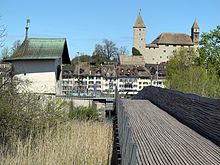
Lake Zurich is a lake in Switzerland, extending southeast of the city of Zürich. Depending on the context, Lake Zurich or Zürichsee can be used to describe the lake as a whole, or just that part of the lake downstream of the Seedamm at Rapperswil, whilst the part upstream of Rapperswil may be called the Obersee or Upper Lake.
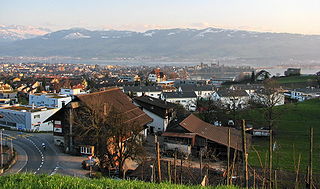
Rapperswil-Jona is a municipality in the Wahlkreis (constituency) of See-Gaster in the canton of St. Gallen in Switzerland. Besides Rapperswil and Jona, which were separate municipalities until 2006, Rapperswil-Jona also includes Bollingen, Busskirch, Curtiberg, Kempraten-Lenggis, Wagen, and Wurmsbach.

Lützelau is an island located, with the neighbouring island of Ufenau, in Lake Zürich in Switzerland between Rapperswil and Freienbach.

Jona is a former municipality and since January 2007 part of the municipality of Rapperswil-Jona in the Wahlkreis (constituency) of See-Gaster in the canton of St. Gallen in Switzerland. Before the merger with Rapperswil, the former municipality of Jona comprised the villages of Jona, Bollingen, Busskirch, Curtiberg, Kempraten-Lenggis, Wagen and Wurmsbach.

Rapperswil is a former municipality and since January 2007 part of the municipality of Rapperswil-Jona in the Wahlkreis (constituency) of See-Gaster in the canton of St. Gallen in Switzerland, located between Obersee and the main part of Lake Zurich.

Kempraten-Lenggis is a village (Kirchdorf) within the municipality of Rapperswil-Jona, Wahlkreis (constituency) of See-Gaster in the canton of St. Gallen in Switzerland. The remains of the Gallo-Roman settlement Centum Prata are one of the most important archaeological sites in the canton of St. Gallen; Centrum Prata is located at the so-called Kempratnerbucht, in Rapperswil and Busskirch on Zürichsee lake shore.

The Rapperswil Seedamm is the artificial causeway at the narrowest area of Lake Zurich between Hurden (SZ) and Rapperswil (SG). The structure contains two bridge segments and is approximately 1 kilometre (0.62 mi) long. The Seedamm carries a road and a railway across the lake, with the railway being used by the S5 and S40 lines of the S-Bahn Zürich and by the Südostbahn Voralpen Express.

Rapperswil Castle is a castle, built in the early 13th century by the House of Rapperswil, in the formerly independent city of Rapperswil.
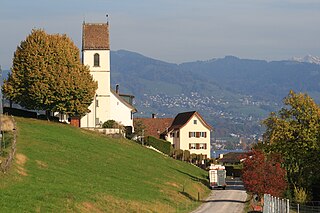
Bollingen is a village (Kirchdorf) within the municipality of Rapperswil-Jona in the Swiss canton of St. Gallen.
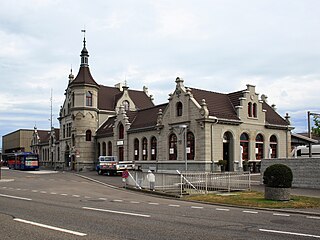
Rapperswil railway station is located next to the old town and harbour of Rapperswil in the Swiss canton of St. Gallen. It is the largest of four active railway stations in the municipality of Rapperswil-Jona. Rapperswil railway station is situated on the north shore of Lake Zürich at the northern end of the Seedamm, which separates the Obersee from the main body of the lake.

Busskirch is a village (Kirchdorf) within the municipality of Rapperswil-Jona in the canton of St. Gallen, Switzerland.
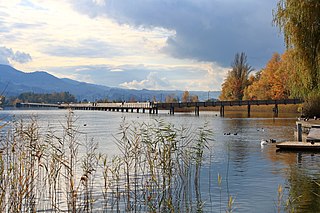
Holzbrücke Rapperswil-Hurden is a wooden pedestrian bridge between the city of Rapperswil and the village of Hurden crossing the Obersee in Switzerland. On 6 April 2001, the footbridge was opened. With a length of 841 metres (2,759 ft) it is the longest wooden bridge in Switzerland.

Hurden is a village in the municipality of Freienbach in the canton of Schwyz in Switzerland. First mentioned in 1217, the name "de Hurden" was used for the peninsula and for the fish traps made of woven work, called "Hürden" or "Hurden", which were used by the locals.

Verkehrsbetriebe Zürichsee und Oberland (VZO) is a public transport operator in the region between Lake Zürich and the Zürcher Oberland to the south-east of the city of Zürich in the canton of Zürich. It operates bus services between the various communities of this region and, since 2008, in the adjoining municipality of Rapperswil-Jona in the canton of St Gallen.

Elisabeth von Rapperswil was the last countess of the House of Rapperswil, and secured by her second marriage the female line of the Counts of Rapperswil and the extensive possessions of Rapperswil in the former Zürichgau to the Laufenburg line. Her son by first marriage was Reichsvogt Wernher von Homberg, and her oldest son by second marriage was Count Johann von Habsburg-Laufenburg who passed over the title of the count of Rapperswil to his oldest son Johann II and his brothers Rudolf and Gotfried.

The Obersee is the smaller of the two parts of Zürichsee in the cantons of St. Gallen and Schwyz in Switzerland.

Centum Prata is the name of a Roman vicus, whose remains are located on the eastern Zürichsee lakeshore in Kempraten, a locality of the municipality Rapperswil-Jona in the canton of St. Gallen in Switzerland. Centum Prata is the most important archaeological site from the Gallo-Roman era in the canton of St. Gallen.

Buechberg is an elongated molasse hill in the Swiss cantons of Schwyz and St. Gallen on Obersee lakeshore.

Lindenhof in Rapperswil is a moraine hill and a public square being the historic center of Rapperswil, Switzerland.

Rapperswil-Jona/Hombrechtikon–Feldbach is one of the 111 serial sites of the UNESCO World Heritage Site Prehistoric pile dwellings around the Alps, of which are 56 located in Switzerland.
